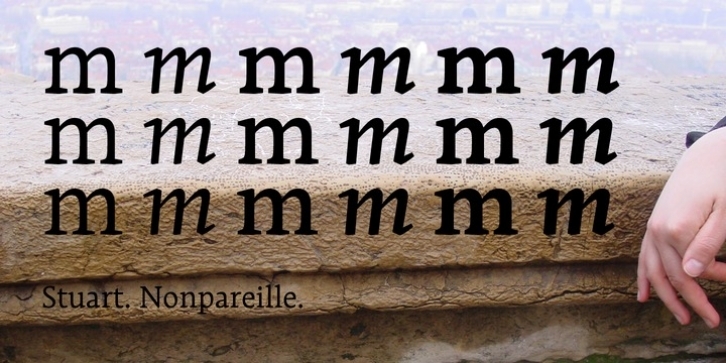«Back ·
Stuart Standard Font



 Designer:
Designer: Matthieu Cortat
Publisher: Nonpareille
Punchcutters (when types needed to be cut, and not simply drawn), were working with steel, a strong metal they had to sculpt. They were subject to physical contingencies: each type cast was inscribed separatly and, as we move down into the smaller type sizes, the illustration was adjusted to brand-new particular information experienced-- great hairlines-- hence vulnerable-- require to be strengthened, the curves streamlined and the width spacing slightly increased to avoid the ink from blocking the structure. So, each body size had its own illustration, primarily provided by merely physical limitations associating with the dexterity and vision of the punchcutter ... and of the reader, too.
Whereas nowadays it is simpler to move from one type size to another, many digital fonts use us just ONE style, irrespective of the selected type size. Although computers complimentary us from a great deal of the restrictive physical elements of lead structure, will we not be tossing the baby out with the bathwater and losing an essential subtlety? Where the cutter's corrections not an essential part of making sure that a text was effectively legible-- of its appeal-- rather of being no more than a technical flaw with which the computer has actually successfully done away?
The Stuart font restores links to this lost method of doing things by offering three designs for a single typeface. First off the Stuart caption, which is ideal for usage with type sizes of below 8 points; it has the characteristics of small sizes types: downstrokes and hairlines not especially marked, larger spacing and solid shapes. On the contrary, at the other end of the scale the Stuart entitling, developed for type sizes of over 12 points, has marked downstrokes and hairlines, a narrower width spacing and a particular lightness of shape. Between the two, for type sizes between 8 and 12 points (the most commonly used) there is the Stuart text.
Stuart is created for graphic design with great resistance for long (in theory literary) texts. Based on a venetian design, with "latin" curves moderated by a strict modernist regularity, it is offered for all european languages, and offers a very wide variety of signs, like 3 styles of figures and mathematical indications, small capitals, ligatures, exponent, portions, etc.
It is readily available in routine, medium and strong weights, each of them broken down into roman and italic styles.
For general users, it can be purchased in "basic" variation, divided in OSF (Old design figures) for long texts, TLF (Tabular Lining Figures) for tables, PLF (Proportional lining figures) for titles entirely in capitals, and SC (Little capitals) with lower case replaced by small caps.
For the special requirements of precision, subtleties and refinements for graphic and book designers, there is also a more total "pro" version. All the ranges of the basic variation are here folded in one single typeface. It likewise provided additional ligatures, superiors, inferiors, and fractions that the standard variation do not.
Font Family: Tags: book, book text, clean, elegant, expert, heavy, latin, legible, news, old-style numerals, print, serif, venetian




 Punchcutters (when types needed to be cut, and not simply drawn), were working with steel, a strong metal they had to sculpt. They were subject to physical contingencies: each type cast was inscribed separatly and, as we move down into the smaller type sizes, the illustration was adjusted to brand-new particular information experienced-- great hairlines-- hence vulnerable-- require to be strengthened, the curves streamlined and the width spacing slightly increased to avoid the ink from blocking the structure. So, each body size had its own illustration, primarily provided by merely physical limitations associating with the dexterity and vision of the punchcutter ... and of the reader, too.
Punchcutters (when types needed to be cut, and not simply drawn), were working with steel, a strong metal they had to sculpt. They were subject to physical contingencies: each type cast was inscribed separatly and, as we move down into the smaller type sizes, the illustration was adjusted to brand-new particular information experienced-- great hairlines-- hence vulnerable-- require to be strengthened, the curves streamlined and the width spacing slightly increased to avoid the ink from blocking the structure. So, each body size had its own illustration, primarily provided by merely physical limitations associating with the dexterity and vision of the punchcutter ... and of the reader, too. 
